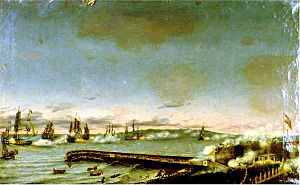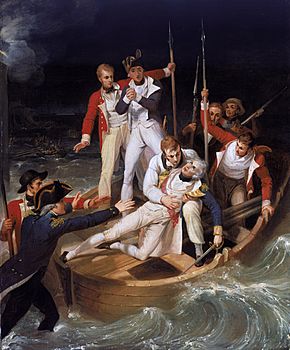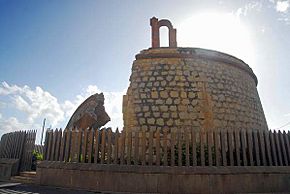Battle of Santa Cruz de Tenerife (1797) facts for kids
Quick facts for kids Battle of Santa Cruz de Tenerife |
|||||||
|---|---|---|---|---|---|---|---|
| Part of the War of the First Coalition | |||||||
 The British Attack on Santa Cruz de Tenerife. Oil on canvas, 1848. |
|||||||
|
|||||||
| Belligerents | |||||||
| Commanders and leaders | |||||||
| Strength | |||||||
|
|
||||||
| Casualties and losses | |||||||
|
|
||||||
The Battle of Santa Cruz de Tenerife was a big fight between the Royal Navy (British navy) and the Spanish city of Santa Cruz de Tenerife. This city is a port in the Canary Islands, which belong to Spain. The British, led by Rear-Admiral Horatio Nelson, attacked from the sea on July 22, 1797. But the Spanish defenders won!
By July 25, the British soldiers who had landed had to retreat. They had lost hundreds of men. Nelson himself was badly hurt in his arm, which had to be partly cut off. This injury was a constant reminder of his failure in this battle.
Contents
Why Did the Battle Happen?
After Cape St. Vincent and Cádiz
In February 1797, the British navy beat a Spanish fleet near Cape St. Vincent. But the British Admiral, John Jervis, was upset. He couldn't capture some important Spanish ships, like the Santísima Trinidad.
The British leaders then told Jervis to block the Spanish port of Cádiz. Many damaged Spanish ships were hiding there. The British thought it would be easy to win, but they were wrong.
Spanish Resistance at Cádiz
Jervis's ships tried to block Cádiz, but the Spanish fought back. The Spanish, led by Vice-Admiral Mazarredo, used small gunboats. These boats were fast in the shallow water of the harbor. They attacked the big British ships at night.
Spanish cannons on the coast also fired, along with their warships in the harbor. They pushed the British away. This allowed Spanish merchant ships to get in and out of the port.
Nelson's Plan for Tenerife
The British sailors were getting tired and frustrated. They had been at sea for a long time with no clear wins. In April, Admiral Jervis heard that Spanish treasure ships from America often stopped at Tenerife.
He sent two British ships to check it out. These ships surprised and captured two French and Spanish vessels at night. This success made Jervis hopeful. He sent a small group of ships, led by Rear Admiral Horatio Nelson, to capture Santa Cruz. Nelson's plan was to attack the city from the sea.
How the Battle Unfolded
Nelson's Fleet Arrives
On July 14, Nelson sailed towards the Canary Islands. He was on his main ship, HMS Theseus. His group included three large 74-gun ships: Culloden , HMS Zealous. It also had three smaller frigates: HMS Seahorse, HMS Emerald, and HMS Terpsichore.
There was also a small cutter called Fox and a mortar boat, the Ray. Later, HMS Leander (a 50-gun ship) joined them. The British had 400 cannons and almost 4,000 men. They reached Santa Cruz on July 17.
Spanish Preparations
In Santa Cruz, Lieutenant General Antonio Gutiérrez de Otero y Santayana was in charge. He had already beaten the British twice before. After the British raid in April, he quickly got ready to defend the city.
He rebuilt forts and added more cannons, making 91 gun positions. General Gutiérrez gathered about 1,700 men. These included soldiers, local hunters, militia, artillery experts, and sailors.
British Attack Plans
Nelson's plan was to land troops at night. The smaller frigates would sneak close to the shore. Soldiers would then get off the ships and attack the Spanish cannons north of the harbor. The mortar boat Ray would then fire at the city.
At dawn, Nelson's big ships would enter the harbor. They would capture Spanish merchant ships and their goods. Nelson sent a message to the Spanish. He demanded they surrender all their cargo. He threatened to destroy the city if they didn't.
On July 20, Nelson and his captains finalized the plan. The attack would happen in two parts. First, 1,000 sailors and marines would land at Valleseco beach. This was about two miles north of Santa Cruz harbor. From there, they would surround and capture Fort Paso Alto. If the city still didn't surrender, they would march to the port and attack. Each big ship provided 200 men, and each frigate provided 100. They also had 80 artillerymen.
The Battle Begins
First Attempt: Night Landing
The plan started the next evening. On the clear summer night, the people of Santa Cruz saw blurry shapes moving towards the pier. These were the British boats carrying soldiers. They were in two groups. One group of 23 boats headed for a cliff called Bufadero. The other 16 boats went straight for the city.
The Spanish knew the British were coming. Strong currents held the British back. The big British ships couldn't get close enough to fire their cannons at the city. The frigates could get closer, but their cannons couldn't aim high enough. The British only had one mortar, which couldn't do much damage.
Spanish cannons began firing heavily at the boats, damaging some. The currents were too strong, so the British decided to go back to their ships.
Second Attempt: Landing at Valleseco
In a second try, boats pulled the frigates close to Bufadero. Despite fire from Paso Alto castle and strong currents, 1,000 British soldiers landed at Valleseco beach. They brought some equipment with them. It was the middle of the night, and many boats didn't reach the right spot. British officers didn't know the area well.
On July 23, there was heavy cannon and musket fire. General Gutiérrez brought more soldiers to the castle. He also moved troops from the Santa Cruz fortress to Paso Alto. The British were under pressure and lost two men. Nelson called his troops back to the ships.
The British frigates then fired at the cliffs near Candelaria beach. They hoped to scare the Spanish defenders. Gutiérrez guessed Nelson's next move. He moved most of his artillerymen to the port cannons. He left only 30 militia men at Paso Alto. The British couldn't see these movements. They thought the Spanish force was much larger than it was.


Nelson's Direct Attack
Nelson was very angry about the failed first attack. He gathered his captains on his ship, Theseus. He told them he would lead the next attack himself. He would lead a group of boats, followed by five more led by his captains. They would go straight to the San Cristóbal castle in Santa Cruz harbor. General Gutiérrez had gathered his best troops there.
To be quiet, the British used cloth-padded oars. They set off at 10:30 p.m. on July 24. A Spanish frigate, San José, fired an alarm shot when its sailors heard the British boats getting close. The water was rough. About 700 British soldiers were in the boats. Another 180 were in the cutter Fox, and 80 in a captured Canary sloop.
General Gutiérrez had spread his forces out. Besides San Cristóbal castle, he had troops at Pila square, Santos stream, Carnicerías beach, and Santo Domingo monastery.
Fierce Fighting and Nelson's Injury
Around 11:00 p.m., cannonballs and musket bullets rained down on the British. They came from the batteries of Paso Alto, San Miguel, San Antonio, and San Pedro. The British ammunition was wet from the sea. Several shots hit the cutter's hull.
Some boats reached the beaches. Marines managed to disable a few cannons. But other boats drifted away. Spanish mortars and cannons focused on the successful British sailors, wiping them out. Many British soldiers were killed on the beach. A huge line of fire targeted the small boats. Before midnight, the cutter Fox was hit and sank. Its commander, Gibson, and 17 men drowned.
British forces led by Captain Bowen quickly attacked the cannon battery covering the harbor. They captured it and disabled its guns. They chased the fleeing Spanish into the town. But they were met with a hail of grapeshot (small metal balls fired from cannons). Bowen, his first officer, and several men were killed.
Nelson, who was just landing from his boat, was hit in his right arm. Soldiers who reached the beach were shot at from house terraces and windows. The citizens of Santa Cruz helped fight off the attack. After the victory, some were given honors and medals.
Nelson was bleeding a lot. His stepson, Lieutenant Nisbet, quickly tied a handkerchief tightly around Nelson's arm to stop the bleeding. Nelson refused to be taken back to his main ship on a nearby frigate. He didn't want Captain Fremantle to raise a distress flag, which would make his crews lose hope.
Instead, his boat's sailors rowed hard back to the Theseus. The surgeon was ready. Nelson reportedly said, pointing to his arm, "Doctor, I want to get rid of this useless piece of flesh here." Nelson's operation was fast. Most of his arm was cut off. The arm was thrown overboard, which was common then, even though Nelson wanted to keep it.
British Retreat
The Spanish cannons fired even more. They saw that almost half of the thousand British soldiers had landed at Carnicerías beach. These men were trying to get into the city. Captains Troubridge and Hood, leading 350 men, took over La Consolación convent.
However, the rest of the British troops were defeated. They tried to attack San Cristóbal fortress from behind. Troubridge knew his situation was bad. He had no support from ships or more soldiers coming. But he sent a message to Gutiérrez. He demanded the surrender of the San Jose ship, or he would burn the town. Gutiérrez, an experienced soldier, refused.
The Spanish general ordered more firing on the British soldiers stuck in the convent. He also brought more artillerymen to the cannons closer to La Consolación.
Other British forces landed at Las Carnicerías. They moved through the Santos cliff. Despite heavy fire from Spanish forts, these men joined Troubridge. They were then trapped in Sto. Domingo square.
Gutiérrez had his Canarias battalion block the pier. This meant Troubridge couldn't escape back to his ships. No help could come in either. Two groups of Spanish soldiers headed for the harbor. One went behind Sto. Domingo square to stop the British from moving further into the city. The other went along the coast.
In the morning, Nelson, who was recovering, tried to help Troubridge. He sent 15 boats to the pier. Around 1:00 a.m., Spanish gunfire destroyed the small group of boats. Three were sunk, and over 30 men drowned. The rest rowed back in shock.
Captain Troubridge sent another message to Gutiérrez. He asked for honorable terms to leave. Gutiérrez agreed. By 7:00 a.m., a truce was signed. This allowed the remaining British forces to return to their ships with full military honors. In return, Captain Hood promised not to burn the town. He also promised not to attack Tenerife or the Canary Islands again.
What Happened After?
The Spanish had only 30 dead and 40 injured. The British lost 250 dead and 128 wounded. The trip back to England was hard for Nelson, as he had lost many men.
General Gutiérrez lent Nelson two small ships to help the damaged British fleet return. The Spanish general also let the British leave with their weapons and military honors. When Nelson returned to England, he sent a thank-you letter to Gutiérrez. He also sent some beer and English cheese. Gutiérrez replied with another letter, and some Spanish wine and cheese. These acts of kindness led to a friendly exchange of letters between Nelson and Gutiérrez.
However, Nelson later said that Tenerife was the worst place he had ever been. This was not just because he lost his arm. Nelson's letter offering cheese is now on display at the new Spanish Army Museum in Toledo.
Nelson agreed to report the news of the attack back to Spain. The frigate Esmeralda arrived in Cádiz in late July. It carried news of Gutiérrez's victory. Jervis had expected the British flag to be flying over Santa Cruz. He was very angry when he heard about the failure. The British never tried to capture Santa Cruz again.
How is it Remembered Today?
Every July, a special event called the Recreation Gesta July 25 takes place in Santa Cruz de Tenerife. Soldiers wear old uniforms and use weapons from that time. They act out the battle to remember the Spanish victory over the British.
In Santa Cruz, where the old Castle of San Cristóbal used to be, there is a small museum. It displays the cannon that is believed to have injured Nelson. Its name is El Tigre (The Tiger).
See also
 In Spanish: Batalla de Santa Cruz de Tenerife (1797) para niños
In Spanish: Batalla de Santa Cruz de Tenerife (1797) para niños

